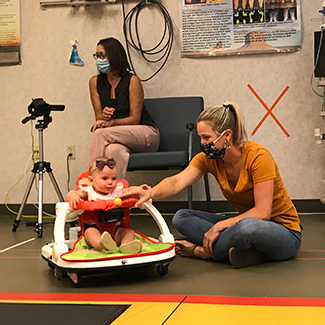'Baby Bug' Mobility Invention Allows Child to Move Around
An Invention Could Open Countless Possibilities for the Youngest of Patients
The latest invention from the Shriners Hospitals for Children — Salt Lake City wheelchair, seating and mobility department is more than just a way for our youngest patients to learn to get around. It’s also a groundbreaking tool that encourages their overall development. The “Baby Bug,” a two-motor power mobility chair for infants, was created by Ken Kozole, BSME, OTR/L, and his team to help babies who are missing crucial developmental milestones because they are unable to crawl or walk independently.
A Reason to Move
In the first two years of life, a child’s development is a complex series of events that are critical in forming the framework for growth into adulthood. Research shows typically developing children have accelerated developmental achievements when they acquire the ability to crawl, creep and walk. These early movements are responsible for rapid growth, social relationships, receptive and expressive speech, and spatial awareness. Children unable to move independently are at risk for delays in these areas, and when they’re really young, they’re too small for wheelchairs.
Scott Jerome, MPT, a physical therapist in the wheelchair, seating and mobility department, explained: “Kids with special needs who don’t have independent mobility miss out on exploring the world around them and the benefits that come with it. Possible social and cognitive milestones are missed.”
That’s why Kozole, a longtime Shriners Hospitals for Children — Salt Lake City wheelchair seating and mobility clinician, worked with his team and the Open Wheelchair Foundation to develop the prototype of the Baby Bug.
The Journey of the Baby Bug
The Baby Bug is made with a low-profile base on sturdy wheels, electronically powered and programmable, with a joystick for control. The seat is made from the commercially available Sit-Me-Up baby seat.
Before it can be offered to patients, the Baby Bug must undergo a rigorous study. As part of that research, the staff recruited babies of Shriners Hospitals staff and community members to determine the optimal age for babies to use the Baby Bug, and to assess how children are able to use the joystick. Several employees were eager to enroll their children, including physical therapist Crystal Haakenson, D.P.T.
“I support all the research we do here at Shriners Hospitals,” said Haakenson. “We need to gather a lot of information on how kids respond, so we know how to help kids who need more assistance and give them the greatest chance to learn.”
Haakenson brought her 7-month-old daughter, Jovie, to the hospital’s motion analysis center. The sessions start with a one-hour assessment of the child’s motor skills before using the Baby Bug. The parent is also asked to fill out a questionnaire about the child’s development.
When Haakenson placed her baby in the device, Jovie took to it right away, expertly maneuvering the joystick as she traveled the length of the motion analysis center with ease – with the staff and her mom cheering her on. As Jovie used the Baby Bug, cameras captured and recorded her movements and interactions to determine how often she was looking at the joystick and driving the device independently, and when she needed her mother’s help.
The next step in the study is to test the prototype with a patient. A child diagnosed with arthrogryposis will take a device home for use and monitoring over a six-month period. Staff members will follow up with the family on a monthly basis to record the child’s progress and monitor mobility skills.
Mobility for Life
The mobility team at the Salt Lake City hospital strives to help patients with mobility needs throughout their lives. “The Baby Bug helps us bridge the early gap in developing power mobility for children with mobility impairments, from infancy into adulthood,” said Jerome.
Once babies outgrow the Baby Bug, they will begin to use a modified Go Chair customized by hospital staff members for children as young as 17 months. The Go Chair is small, contains a simple power base with joystick controls and is easy to transport and operate. Shriners Hospitals for Children — Salt Lake City’s wheelchair, seating and mobility department has delivered more than 420 of these modified Go Chairs to children throughout Utah, the Western states and parts of Mexico.
Mobility for All
While there are currently other pediatric mobility apparatuses available, they’re expensive and difficult to obtain. Shriners Hospitals for Children plans to work with foundations and corporations to make the relatively inexpensive Baby Bug readily available to patients regardless of their family’s ability to pay.
“What’s happening here is revolutionary, cutting-edge information that needs to be shared,” said Jerome. To this end, the Salt Lake City team is already working with Shriners Hospitals for Children — Chicago physician Sue Mukherjee, M.D., to potentially duplicate this study at that hospital.
For more information on this program, call 801-536-3500.
This story was originally published in Leaders in CARE - stories of the most amazing care anywhere, from Shriners Hospitals for Children. Access the article within the publication.

Keep In Touch
Join our mailing list to stay up to date on everything that's happening at Shriners Children's.
